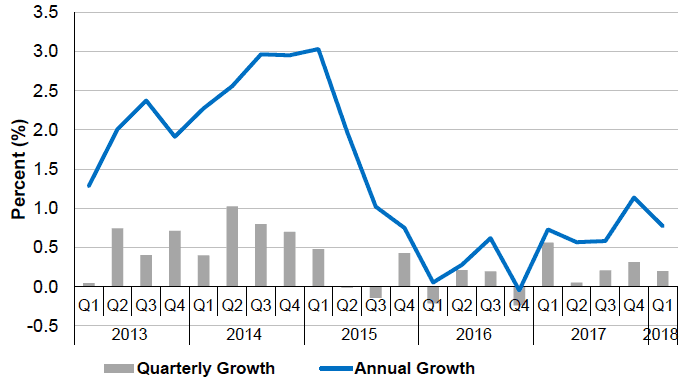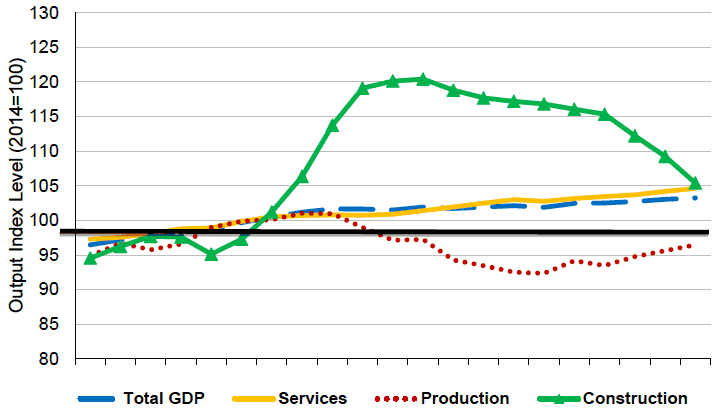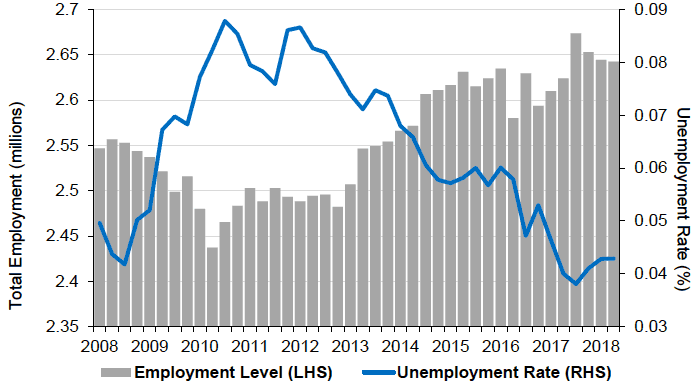Council of Economic Advisers: Chair's report 2016-2018
An overview of how the Council operates, and the areas they focused on from 2016 to 2018.
2 - Economic Developments 2016 – 2018
A key aspect of our formal meetings is to discuss current and emerging economic trends with the First Minister. A report on the state of the Scottish economy, presented by the Chief Economist, supports this discussion. Four such reports were published across the time period - October 2016, June and November 2017, and January 2018 – available on the Scottish Government website [5].
When reporting on Scotland's Economic performance across 2016 to 2018, it is important to consider the major economic events affecting Scotland – in particular the UK referendum vote to leave the European Union as well as the on-going effects of the fall in oil prices in 2014-15 and their subsequent recovery.
This chapter provides an overview of recent economic developments, including how we have engaged with emerging analysis on the impacts of Brexit in Scotland, and two key updates in economic data.
2.1. Context
Key Economic Trends
Gross Domestic Product
Across 2016 and 2017, the Scottish economy remained resilient despite challenging economic conditions that continued to be dominated by heightened uncertainty as the UK moves closer to leaving the EU. Scotland's economic performance strengthened in the final quarter of 2017, completing a year that saw growth stronger than in 2016, however, remains below the long run trend rate. See Figure 1 below.
Calendar year growth in the Scottish economy was 0.8% in 2017, following growth of 0.2% in 2016 and 1.7% in 2015. The equivalent UK growth rate for 2017 was 1.8%.
Figure 1: Scottish GDP Growth, 2013-2017

Source: Scottish Government
Figure 2: Scottish Output Levels by Sector, 2013-2017

Source: Scottish Government
Stronger growth in 2017 was supported by the continuation of moderate growth in the Services sector. See Figure 2 above. In the final quarter of the year, annual growth in the sector accelerated to 1.4%, supported by a pick-up in growth in Distribution, Hotels and Catering (3.2%) and Business Services and Finance (1.0%).
A key change in performance in 2017 was the return to growth in the Production sector which achieved annual growth of 3.4% in the final quarter of the year. Stronger growth in the Mining and Quarrying Industries (6.2%) and Manufacturing (2.9%) have been supported by the improved export environment (stronger international growth and the relatively weak value of Sterling), alongside the gradual strengthening of economic sentiment and activity in the oil and gas sector.
The Construction sector contracted for its second consecutive year in 2017 with annual output contracting 6.5% in the final quarter as output from the sector adjusts back to more normal levels following exceptionally rapid output growth in 2015.
Since 2014, the construction industry business cycle has been driven by a number of high value public and private sector projects, particularly the construction of large transport and industrial infrastructure developments. Many of these projects have completed and output in the sector is returning to a more normal level, supported by on-going infrastructure projects such as the Aberdeen bypass and the Edinburgh-Glasgow rail improvements.
In the latest quarter, Scotland's annual construction output as a proportion of total construction output in Great Britain fell back to 8.4% from its peak of 10.0% in 2015, - its highest share since 1993 – now below the long term average of around 9.0%, indicating that the current cycle of contraction is nearing its completion,
Despite the readjustments since 2015, construction output is 15% higher than it was at the beginning of 2014, compared to overall GDP growth of only 4.5% over the same four year period.
The Scottish economy will continue to be influenced by factors such as the strengthening of sentiment and activity in the Oil and Gas sector alongside the construction sector completing its current business cycle, which should be supporting of growth in the medium term.
However, Brexit remains the key source of uncertainty to Scotland's economy. As we move towards March 2019, the extent to which positive expectations outweigh uncertainty will be crucial to driving medium term output growth. Scotland's economy is expected to continue to grow below trend levels in 2018 and 2019, with independent forecasters projecting growth of around 1% in both years.
Labour Market
2,642,000 people were in employment in Feb-Apr 2018, 78,000 more than the pre-recession peak (Mar-May 2008), see Figure 3 below.
Since 2016, Scotland's labour market has performed strongly, with 62,000 more people in employment, 90 per cent of the increase coming from full time employment. In the same period the unemployment rate decreased by 1.5 percentage points to 4.3%.
Over the latest year to Feb-Apr 2018 the employment level has increased at a slower pace, with 18,000 more people in employment. The employment rate at 75.2% is slightly below the UK rate of 75.6%. The unemployment rate also increased by 0.3 percentage points over the latest year to Feb-Apr 2018, however at 4.3% remains close to the lowest unemployment rates in the series.
Youth unemployment rate has been on a downward trend since 2012, and in 2018 was 8.9%, down 2.9 percentage points since 2008. Likewise, Scotland has been performing well on measures of female employment exceeding the UK on female employment and unemployment rates.
Figure 3: Employment and Unemployment Rates in Scotland, 2008-2018

Source: Scottish Government
2.2. Discussion
Emerging evidence on the impact of Brexit
Following the result of June's referendum on membership of the European Union, the First Minister established a Standing Council on Europe to provide advice to Scottish Ministers and the Scottish Government on protecting Scotland's relationship with the EU. The Chair is Anton Muscatelli, who also sits on the Council of Economic Advisers. In the August 2016 meeting of the CEA, we agreed that we would provide advice on the economic impacts of Brexit for Scotland, to complement the work of the First Minister's Standing Council on Europe.
We paid particular attention to the two reports published by the Scottish Government in December 2016 - Scotland's Place in Europe [6] - and January 2018 - Scotland's Place in Europe: People, Jobs and Investment [7]. The Council discussed the economic impacts as part of our meetings, given the significance of EU exit. The analysis published was important in setting out potential impacts across different scenarios. In our considerations thus far, we are supportive of the robust and thorough analysis undertaken by the Scottish Government. Going forward, continuing to build the evidence of the potential impacts of Brexit is vital; including scenario planning, in particular trade scenarios, and looking at the risks and opportunities for Scotland. The Council believes that continuing to provide those living in Scotland, and those with interests in Scotland, with timely and accurate information on the impacts of Scotland leaving the European Union is highly important.
Scotland's Place in Europe
- First report: December 2016
The initial report set out Scottish Government proposals to protect Scotland's interests. Primarily, this paper set out the importance of single market membership to the Scottish economy. The Scottish Government presented evidence that the European single market has helped reduce barriers to trade and facilitated the movement of goods, services, people, and capital. The report found that the result has been greater competition, increased employment and investment opportunities across member states, highlighting the importance of progress made towards a single market in services (particularly in areas like financial services) from a Scottish perspective.
In addition, the paper pointed out that economic theory and evidence shows that increasing trade can enhance economic performance and contribute towards improvement across a range of economic outcomes. Evidence shows that trade also has a number of wider benefits such as companies exposed to international competition becoming more productive, innovative and grow faster. In addition, free movement of people has also led to improvements in the Scottish economy as well as contributing positively to the public finances and helping to fill skill gaps.
It also contained a discussion of the short-term impacts of the referendum result – noting a reduction in economic confidence, with weak consumer and business sentiment indexes both showing lower levels of confidence and higher levels of uncertainty. There is an associated risk relating to spending and investment decisions in the short term. In the longer term, the paper noted potential impacts for exports, investment, and freedom of movement.
The paper highlighted how interlinked the Scottish economy is with the EU. At time of publication, there was around 181,000 non-UK EU citizens living in Scotland – this had increased to 209,000 by June 2018 – and the EU is the main destination market for Scotland's international exports. There are 1,000, non-UK, EU owned companies operating in Scotland; employing 127,110 people.
- Second report: January 2018
The second paper on the subject produced by the Scottish Government, Scotland's Place in Europe: People, Jobs and Investment, presented the latest Scottish Government analysis of the implications to Scotland's economy if the UK leaves the European Union. This builds on the analysis presented in the initial report, presenting a hierarchy of preferred outcomes and an analytical report for each of the three trade scenarios examined: a free trade agreement (FTA), remaining in the European Economic Area (EEA), or a 'no deal' situation, thereby reverting to World Trade Organisation terms. The paper found that each of the scenarios would result in a permanent decrease in Scotland's GDP relative to continued full EU membership; the least damaging scenario being to remain in the EEA.
The paper also highlighted how exit from the EU may exacerbate demographic problems facing Scotland. Maintaining Scotland's working age population would be a challenge without Brexit, however leaving the EU could make the challenge much more acute.
Developments in Economic Data
The Council continue to emphasise the importance of robust data and analysis across all workstreams and welcomed the Scottish Parliament committee inquiry into economic data in Scotland. In early 2017, we identified two key aspects of economic data to investigate further – business investment and labour productivity – for the purposes of discussing how investment and innovation are driving increasing productivity and sustainable economic growth. The below sections provide a short summary of progress in these data sets and publication.
Labour Productivity
Labour productivity measures the amount of economic output produced, on average, for each unit of labour input. It is an important indicator of economic performance, as increases in productivity can reflect improved skills, innovation and investment, which are key to driving long run growth. Labour productivity statistics are derived from separate data for output and the labour market. Labour input is measured in terms of the number of jobs filled in the economy (giving a measure of output per job) and the total number of hours worked (giving output per hour worked). The data for hours worked includes the entire labour force regardless of age, so there is no technical impact on the measurement of productivity due to an ageing population.
The Scottish Government first produced labour productivity statistics in 2014. These have undergone a number of developments since then, including improvements to the timeliness of release and the level of detail available. From May 2017, labour productivity statistics for Scotland are published on a quarterly basis for the whole economy level, with annual breakdowns of productivity by broad industry group. In May 2018, the first estimates were published of the additive decomposition of annual productivity growth by industry, indicating the contribution made to the headline
Business Investment
Business investment is capital investment, by the market sector of the economy, excluding expenditure on dwellings. This includes the activity of private sector businesses and public corporations such as Scottish Water. Business investment is the largest component of total gross fixed capital formation (GFCF), followed by investment in dwellings and government investment, and forms part of the measurement of GDP using the expenditure approach.
After work to improve data, estimates of business investment and the other components of GFCF have been published in the Quarterly National Accounts Scotland statistics since November 2016. From November 2017, estimates of annual business investment breakdowns by broad industry group have also been published on an experimental basis, while the date sources and methods remain in development. These developments are very welcome. The Scottish Government, along with the ONS and the other devolved administrations, continue to investigate options for improving the raw data for sub-UK business investment.
Contact
There is a problem
Thanks for your feedback